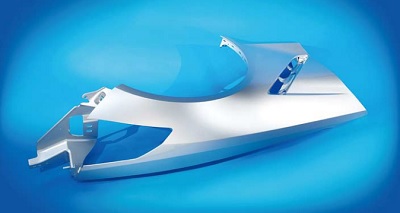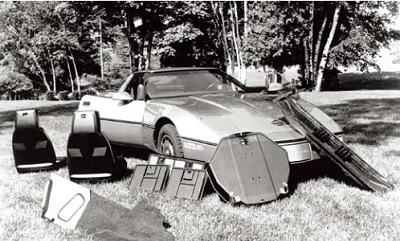The global automotive industry continues to benefit from the technological innovations that yield lightweight, environment-friendly components and parts. Given the importance of transportation, tremendous resources are being poured into the manufacture of automobiles to meet rising demand.
The Automotive Division of the Society of Plastics Engineers (SPE®) announced the category and Grand Award winners for its 45th-annual Automotive Innovation Awards Competition held lst year. The Automotive Innovation Awards is the oldest and largest recognition event in the automotive and plastics industries, and participated by leading companies in the automotive industry and related industries. It is also a reflection of ongoing efforts to develop high-performance parts and components utilizing the latest materials and technologies.
Grand winner
The Materials category winner in 2015 was selected Grand Award winner, representing the most innovative use of plastics by a blue-ribbon panel of judges. In the Materials category, the winner was the Ultralight Class A Body Panels on the 2016 Corvette Stingray convertible sports car from General Motors Co. Tier supplier / material processor / material supplier, Continental Structural Plastics; and toolmaker, Century Tool & Gage & Paragon Die & Engineering Co. also were named on the award.

Grand Award & Materials Category Winner: Ultralight SMC (Image source: SPE Automotive Div.)
The application featured TCA Ultra Lite SMC and was produced via the compression molding process. A new 1.2 SG SMC eliminated 9 kg of body-panel weight after a running change from a mid-density grade, where no tooling changes were required. Suitable for Class A or structural components, the new composite offers 28% mass reduction vs. mid-density (1.6 SG) grades and 43% vs. conventional (1.9 SG) SMC. It provides greater benefits vs. metal, including reduced weight and tooling costs, enhanced design flexibility, corrosion and dent resistance, and superior surface finish. Key to achieving the ultralow density was replacement of CACO3 with hollow-glass microspheres and use of a proprietary surface treatment to improve the resin/reinforcement interface.
Plastic as excellent alternative
The Transparent Lightweight Wind Deflector in the 2016 General Motors Co. Corvette Stingray convertible sports car with material supplied by SABIC won in the Aftermarket category. For the first time, a self-mounted, transparent and frameless wind deflector is used for convertible cars that meets AS2 ANSI and ECE requirements. Lexan 9043 PC with Exatec 900 coating and CNC-trimmed sheet created a steeply raked design that minimizes air turbulence and noise when the top is down. Replacing glass with PC lowered mass 33% and allowed a contoured shape to be achieved that would have been difficult and costly in glass. A laser-etched monogram under the surface is unobtrusive to vision during driving, yet visible during inspection and meets regulatory requirements for glass marking. A plasma coating enhances scratch, chemical, and UV resistance for long use life.
In the Body Interior category, the rear-seat folding head restraint in the 2015 Ford Motor Co. Ford F-150 pickup supplied by the team up of Windsor Machine Group, Hawk Plastics Ltd., ExxonMobil Chemical Co.and' IRC Engineering was given recognition. The rear seat, folding head restraint eliminates a welded steel structure and replaces it with a single-piece, living hinge plastic core as its main structural component. As a result, thickness is reduced 33 mm for improved comfort and rear visibility; mass is reduced 624 g/vehicle, manufacturing complexity is significantly reduced (eliminating the need for special tooling processes thanks to consolidation of 5 parts into 1); tooling costs are lowered; and piece price is reduced $1.50/vehicle, while still meeting or exceeding all global safety requirements.
In the Chassis / Hardware category, the winner was the Fiberglass / Epoxy composite coil spring on the 2015 Audi A6 Avant wagon from Audi AG. Tier supplier / material processor, S. Ara Composite S.A.S.; and material supplier, Hexion Inc. also were named on the award. The application featured Epikote epoxy + fiberglass and was produced via the modified filament winding process. This weight-saving epoxy/fiberglass composite coil spring is the first of its kind to be used in the suspension system of a series-production vehicle. Using a patented, modified filament winding process, the application replaced traditional steel coil springs, reducing weight 40% and enabling the suspension system to react more quickly to changing road surface conditions, thereby improving vehicle handling and NVH. Significant work was done on resin chemistry and resin/fiber interface to ensure efficient load transfer and long-term mechanical performance, as well as finding an efficient, cost-effective production method capable of meeting build volumes.

2015 Hall of Fame Winner - 1984 model Chevrolet Corvette sports car from General Motors Corp.
A move forward in sustainability
In the Environmental category, the winner was the seat fabric from recycled materials on the 2015 Ford F-150 pickup from Ford Motor Co. Tier supplier, Johnson Controls Inc.; material processor, Sage Automotive Interiors; and material supplier, Unifi Manufacturing, Inc. also were named on the award. The application featured Repreve PET and was produced via multiple processes. The fiber used in this innovative seat fabric is made from a hybrid blend of 100% recycled materials, including post-industrial fiber and post-consumer water bottles. The fabric meets Ford design and comfort requirements without any compromise in quality, durability, or performance. The switch from virgin fiber was achieved at cost parity, while providing significant environmental benefits, including diverting over 5-million water bottles from landfills just this year. To help close the loop further, there are now PET bottle collection bins installed at the Ford Research & Engineering campus. These bottles are recycled to help form the fiber.
In the Powertrain category, the winner was the Heated-Tip Fuel Injector on the 2015 Honda Fit subcompact and City sedan from Honda Motor Co. Tier supplier / material processor, Delphi Powertrain; material supplier, DuPont Automotive; and toolmaker, Coltelleria Baldi also were named on the award. The application featured Zytel HTN54G35EF BKB336 PPA and was produced via the injection molding process. An electrical heater within the injector is energized by the vehicle controller, rapidly heating the ethanol fuel and dramatically improving vaporization while reducing emissions. Ink materials used in construction of the heater, body design, the ink-printing process on the body, and overmolding with PPA (which was designed for flow, heat resistance, and electronic compatibility) were all key to the success of this application. The technology saved $60 USD/vehicle as well as 8.8 kg, while improving cold starts on E100 fuel and eliminating the need for a redundant gasoline fuel system on the vehicle.
Strength combined with safety features
In the Body Exterior category, the push-to-release exterior serviceability fastener in the 2015 Ford Motor Co. Ford Mustang sports car was awarded. The fastener was produced by ITW Deltar Fasteners in tandem with Ascend Performance Materials, LLC and A&P Tool, Inc. & M&M Tool and Mold, LLC. Compared to other easy-service fasteners, which have twist heads to release, this injection-molded PA 6/6 fastener only requires that you push the center pin to the service position to remove. This fastener cannot back out or be removed from the installed position without deliberate actions by the customer. The pin and body are designed to not be easily separated; however, the fastener is reusable, unlike other push pins that become damaged in the process of removal. It meets EU lamp serviceability requirements, reducing the time needed to remove the fastener by 90% without tools.
In the Process / Assembly / Enabling Technologies category, the winner was the IMX Instrument Panel on the 2014 Hyundai i20 supermini from Hyundai Motor Group. Tier supplier, Hyundai-Mobis; material processor, HanilEhwa; material supplier, Hanwha L&C; and toolmaker, Hyundai-Motor Co. also were named on the award. The application featured Multiflex 3202 TPO and was produced via the compression-injection molding process. To eliminate scratches and a hard "plastic" feel, a 2-shot compression-injection soft IP was developed. The back-foamed TPO foil is compression-injected with the PP substrate, which in turn is integrally injection molded with the TPO passenger-side airbag door. All the work is done in a single tool. To increase foam softness and stability of the integral injection molding, the TRIZ method and design of experiments tools were used. The resulting part saves $10 USD/vehicle and reduces mass 300 g.
In the Safety category, the winner was the Floor Rocker Reinforcement on the 2015 Jeep Renegade SUV from FCA US LLC. Tier supplier, Proma Group; material processor, Redstamp; material supplier, SABIC; and toolmaker, Redstamp also were named on the award. The application featured Noryl GTX 910 MPPE/PA and was produced via the injection molding process. An optimized MPPE/PA 6 honeycomb geometry in a plastic/metal hybrid proved to be a very efficient energy-absorbing crash-box structure in this floor rocker reinforcement. Not only is the component E-coat capable, but it is very easy to assemble into the vehicle's BIW. Since the plastic honeycomb is integrally attached to 2 steel flanges during injection molding, no structural adhesives are needed. The mixed-material solution took 1 kg of weight out of the BIW, saved approximately 10%, and contributed tooling savings vs. previous steel solutions.
Dozens of teams made up of OEMs, tier suppliers, and polymer producers submit nominations describing their part, system, or complete vehicle and why it merits the claim as the Years Most Innovative Use of Plastics. This annual event typically draws over 700 OEM engineers, automotive and plastics industry executives, and media. As is customary, funds raised from this event are used to support SPE educational efforts and technical seminars, which help educate and secure the role of plastics in the advancement of the automobile.
The mission of SPE is to promote scientific and engineering knowledge relating to plastics worldwide and to educate industry, academia, and the public about these advances. SPEs Automotive Division is active in educating, promoting, recognizing, and communicating technical accomplishments in all phases of plastics and plastic based-composite developments in the global transportation industry. Topic areas include applications, materials, processing, equipment, tooling, design, and development.














